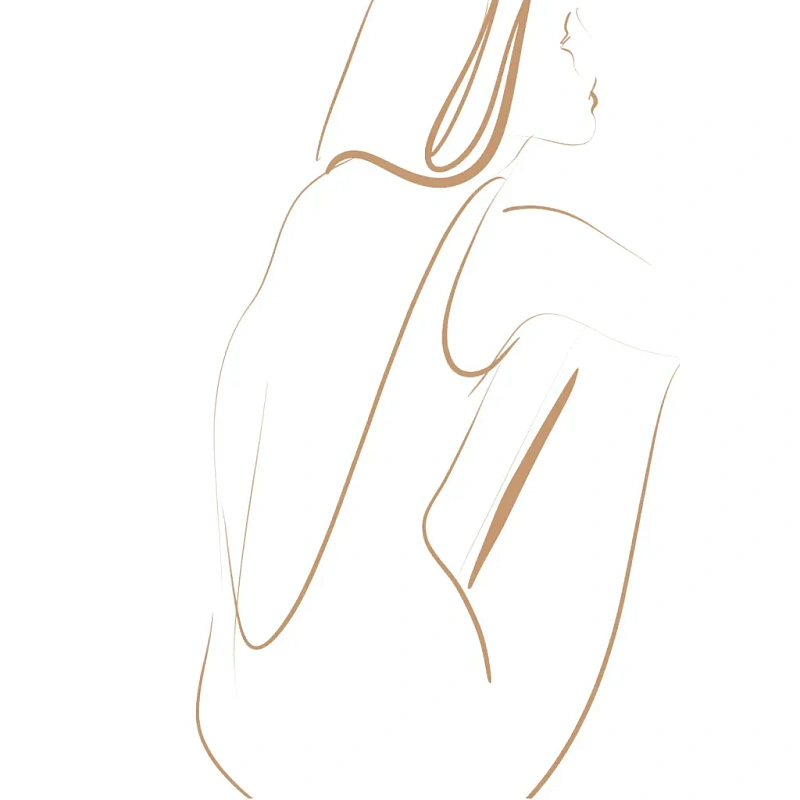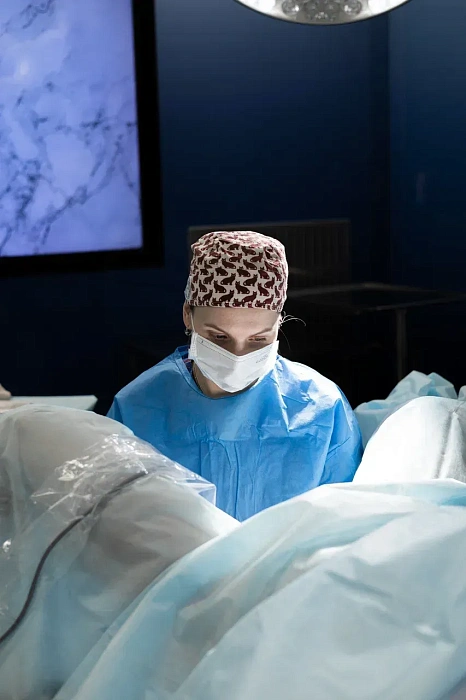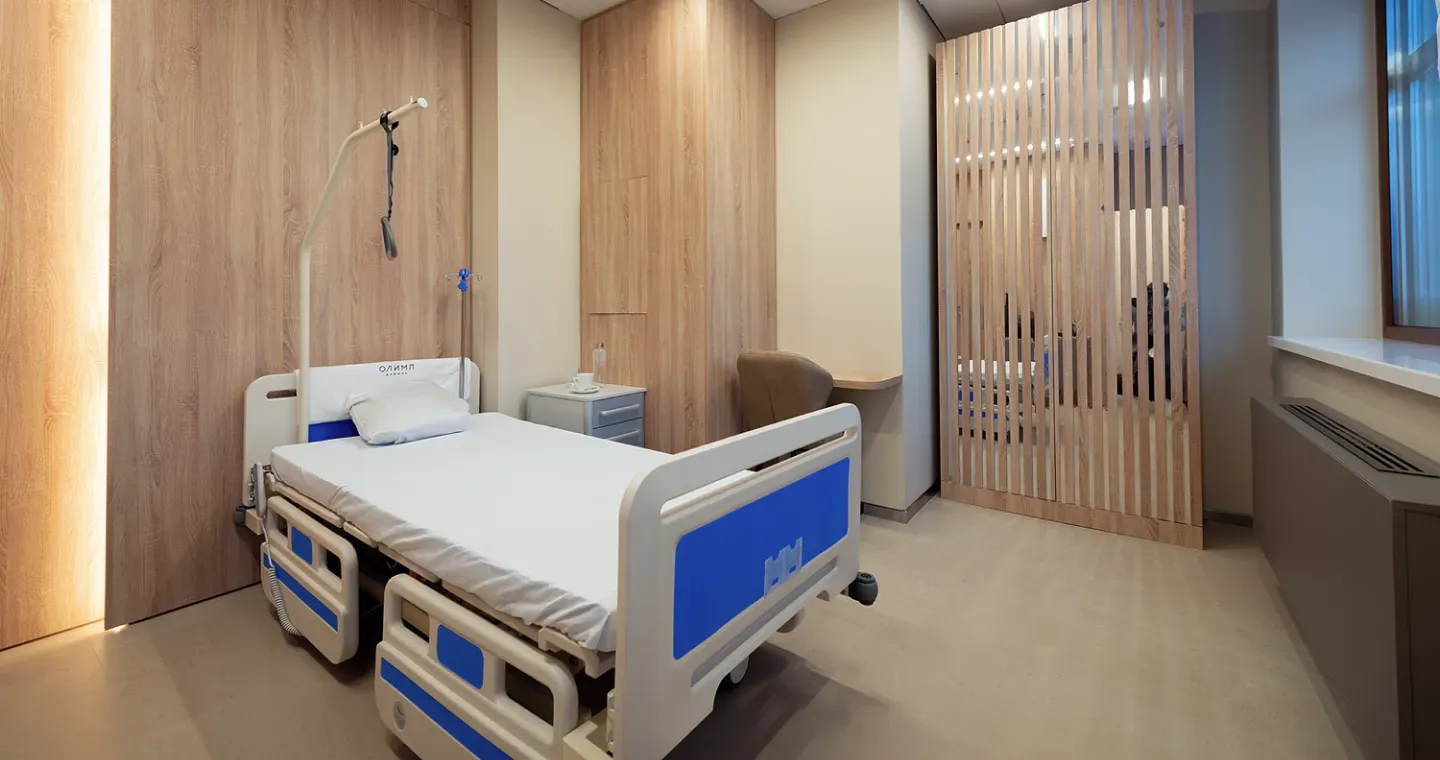Treatment of uterine fibroids
Uterine fibroids can cause unpleasant symptoms, as well as reduce fertility. Modern treatment methods make it possible to remove fibroids, preserving the uterus and reproductive function,

The risk of developing uterine fibroids during life is about 80%, and most often it occurs in women aged 30 to 50 years, during the middle reproductive age.
Fibroids can be accompanied by copious and painful menstruation, pelvic pain, frequent urination and fertility problems. Fibroids rarely turn into sarcoma, a malignant tumor. We offer modern methods of treatment of uterine fibroids, which avoid complete removal of the organ. Laparoscopy and hysteroresectoscopy are minimally invasive interventions aimed at removing myomatous nodes with minimal damage to surrounding tissues.
For surgical treatment of uterine fibroids are used: Laparoscope and hysteroresectoscope with video camera Surgical instruments (scalpels, forceps, coagulators)
Before surgical treatment of uterine fibroids, it is necessary to: Consult with a gynecologist and a surgeon Perform general blood and urine tests Perform an ultrasound examination (ultrasound) or magnetic resonance imaging (MRI) to assess the condition of the myometrium Perform a diagnostic hysteroscopy
Surgical treatment of uterine fibroids is performed using anesthesia. Laparoscopy allows access to myomatous nodes through small punctures on the anterior wall of the abdomen. Using a laparoscope, a thin instrument with a video camera, the surgeon finds and removes myomatous nodes under visual control. This allows you to save the organ and reduce the risk of recurrence of fibroids. Hysteroresectoscopy is used to remove fibroids located inside the uterine cavity. The doctor inserts a hysteroresectoscope through the vagina into the uterine cavity and removes myomatous nodes without damaging the integrity of the uterus. This procedure avoids scarring of the endometrium and preserves the ability to conceive.
After surgical treatment of uterine fibroids, it is important to follow the doctor's recommendations for successful recovery. During 4-6 weeks, it is necessary to refrain from intense physical exertion, avoid visiting the sauna, steam room and solarium, and also avoid hypothermia.
Preparation for organ-preserving treatment of uterine fibroids
During the consultation, the gynecologist-surgeon examines the patient. A comprehensive diagnosis is prescribed: blood and urine tests, a vaginal swab for bakposev. Ultrasound of the pelvic organs and diagnostic hysteroscopy are also performed. Based on the data obtained, the doctor selects the type of operation and determines the time of its implementation. Usually minimally invasive surgery is performed in the first half of the menstrual cycle.

Surgery Surgical treatment of uterine fibroids
Surgical treatment of uterine fibroids is performed using spinal or general anesthesia. Laparoscopy gives access to the foci of fibroids through micro-punctures on the anterior wall of the abdomen. With the help of a laparoscope, a gynecological surgeon finds a tumor and removes myomatous nodes under visual control. Hysteroresectoscopy is performed using a hysteroresectoscope, which is inserted into the uterine cavity through the vagina. The doctor carefully examines the organ, studying the localization, size and shape of the altered tissues, while preserving the uterus.

Rehabilitation after organ-preserving treatment for uterine fibroids
After treatment, it is important to follow the prescriptions and recommendations of a gynecologist. It is necessary to temporarily refrain from visiting the sauna, bathhouse, solarium, avoid hypothermia, control menstruation and note the soreness of secretions. Usually, the next step after minimally invasive surgery is conservative treatment in order to prevent recurrence of the disease.

Frequently Asked Questions
How long does the effect last after treatment?
What are the alternative treatments for fibroids?
How long is the recovery period?
Didn't find an answer to your question?
You can describe your problem in detail and ask a question to the doctor. He will answer you and help you find a solution
Specialists
Find a SpecialistDoctor of the highest category, surgical obstetrician-gynaecologist specialising in anti-age and bioregenerative medicine, oncologist
Indications and contraindications
Indications
Symptomatic fibroids with pain syndrome, cervical localization of the myomatous node
The appearance of a benign tumor in the cervix
Pain in the lower abdomen, copious prolonged menstruation
Uncomfortable sensations during menstruation
Large tumor size
Fibroids, larger in size than a 12-week pregnant uterus
The presence of a submucous node
Benign formation under the uterine mucosa
The presence of a subserous fibroid node on the pedicle
A subserous node connected to the body of the uterus by a pedicle
Infertility, habitual miscarriage
Inability to conceive and bear a child at childbearing age
Expected effect
Reduction of symptoms
Reducing pain and normalizing the menstrual cycle contribute to improving overall well-being.
Preservation of reproductive function
Treatment allows you to save the uterus and, therefore, the possibility of pregnancy in the future.
Getting rid of fibroids
The goal of treatment is the complete disappearance of the tumor.
Prevention of relapses
The use of modern treatment methods is aimed at minimizing the risk of recurrence of fibroids.
Similar referral activities
Consultation of a gynecologist
Medical examination aimed at diagnosing, treating and preventing diseases of the female reproductive system.
Reproductive surgery
Surgical treatment and simultaneous accurate diagnosis of female infertility factors: adhesions, endometriosis, congenital malformations of the genital organs, obstruction of the fallopian tubes, intrauterine pathology (septum and synechia), polycystic ovary syndrome.
Treatment of vulvar diseases
Vulvar diseases, including chronic fissures, sclerotrophic lichen and other dermatological conditions. We offer modern and effective treatment methods aimed at reducing symptoms and restoring the normal condition of the vulva skin.
Correction of menopause problems
The onset of menopause is often accompanied by a number of physical and mental manifestations unpleasant for a woman. The gynecologist will choose therapy, which can relieve or completely eliminate the symptoms.
PRP-therapy with plasma in gynecology
Plasma therapy helps to eliminate dryness, atrophy of the vaginal mucosa by activating cell regeneration, collagen synthesis, and attraction of intercellular fluid.
Vulvoscopy and colposcopy
Instrumental gynecological examinations that help to identify and detect pathology of the female genital organs in the early stages.
How to reach
How to get
From the Belorusskaya metro station of the Zamoskvoretskaya line - exit 4 After exiting the subway, walk through the pedestrian tunnel and climb the stairs. Move towards the railway tracks, go down the stairs immediately after them and walk along the house, then turn right onto 1st Yamskoye Pole Street. At the turn to 3rd Yamsky Pole Street, cross the road at the pedestrian crossing and continue along 1st Yamsky Field Street, after a few buildings on the left you will see Olympus Clinic MARS.
Travel time
9 minutes
Landmark
Olympus Clinic MARS sign
How to get
From the Belorusskaya metro station of the Ring line - exit 2. After exiting the subway, turn left and walk to the pedestrian crossing. Cross the road through two pedestrian crossings and move along the Tverskoy overpass. Go down the stairs immediately after the railway tracks, walk along the house, then turn right onto 1st Yamskoye Pole Street. At the turn to 3rd Yamsky Pole Street, cross the road at the pedestrian crossing and continue along 1st Yamsky Field Street, after a few buildings on the left you will see Olympus Clinic MARS
Travel time
11 minutes
Landmark
Olympus Clinic MARS sign
From the metro station "Tsvetnoy Bulvar"
1 exit to the city, then left to the Garden Ring, at the crossing to the right, crossing the boulevard, one more crossing and at the traffic light to the left. The Olymp Clinic building is located overlooking the Garden Ring to the right of the crossing. Travel time is approximately 9 minutes. Landmark - sign Olymp Clini
From the metro station "Sukharevskaya"
Exit 3 from the metro and 640 meters straight ahead, the clinic will be on the right. Landmark - sign Olymp Clinic
Parking lot map
Exit 3 from the metro and 640 meters straight ahead, the clinic will be on the right. Landmark - sign Olymp Clinic

From Sokol metro station
The last car from the center: follow the signs for Exit 5. From the glass doors to the right and go to the end of the passage. Exit to the city by the steps to the left. After exiting the crossing to the street, go straight along Leningradsky Prospekt to the intersection with Chapaevsky Lane. Next, turn right (onto Chapaevsky Lane) and walk to the Triumph Palace residential complex. Entrance to the territory: through checkpoint No. 1, opposite the Vkusville store, you will need to present your passport. After passing through the checkpoint, go up the stairs to the fountain, opposite it you will see our clinic.
Travel time
10-12 minutes
From the Airport metro station
The first car from the center: follow the Exit 2-3 signs. Turn left out of the glass doors and walk to the end of the passage. After exiting the crossing to the street, go straight along Leningradsky Prospekt to the intersection with Chapaevsky Lane. Next, turn left (onto Chapaevsky Lane) and walk to the Triumph Palace residential complex. Entrance to the territory: through checkpoint No. 1, opposite the Vkusville store, you will need to present your passport. After passing through the checkpoint, go up the stairs to the fountain, opposite it you will see our clinic.
Travel time
12-15 minutes
How to get
Entry to the territory is prohibited, but there are free city parking lots around the Triumph Palace residential complex, where you can easily find a place for your car. Free parking area:






